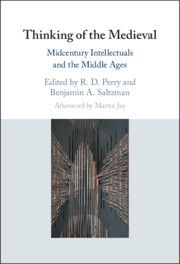Book contents
- Thinking of the Medieval
- Thinking of the Medieval
- Copyright page
- Dedication
- Contents
- Contributors
- Acknowledgments
- About the Cover
- Introduction
- Part I Politics
- Part II Arts
- Part III Epochs
- Chapter 9 Periodization Trouble
- Chapter 10 Medieval Mysticism and the Making of Simone Weil
- Chapter 11 Hermeneutics and the Medieval Horizon
- Afterword
- Bibliography
- Index
Chapter 9 - Periodization Trouble
Auerbach, Huizinga, and the Question of Medieval Realism
from Part III - Epochs
Published online by Cambridge University Press: 07 October 2022
- Thinking of the Medieval
- Thinking of the Medieval
- Copyright page
- Dedication
- Contents
- Contributors
- Acknowledgments
- About the Cover
- Introduction
- Part I Politics
- Part II Arts
- Part III Epochs
- Chapter 9 Periodization Trouble
- Chapter 10 Medieval Mysticism and the Making of Simone Weil
- Chapter 11 Hermeneutics and the Medieval Horizon
- Afterword
- Bibliography
- Index
Summary
Erich Auerbach (1892–1957) and Johan Huizinga (1872–1945) shared an interest in late medieval Burgundian art. My essay reads Auerbach’s famous Mimesis (1946) as addressing one of Huizinga’s most pressing concerns, namely periodization, not only as he articulated them in Autumn of the Middle Ages (1919), but also as they dominated several of his (Huizinga’s) less well-known texts on the Renaissance that challenged the Burckhardt-inflected way both periods were understood at the time. Auerbach’s reception of Huizinga’s understanding in Autumn of late medieval realism in particular in a series of texts beginning in 1921 and running up through 1946 rattled at the foundation of the assumption that periodization was a relevant way of looking at cultural history at all. The alternative represented by his Mimesis focuses, rather, on what Auerbach describes in the “Epilegomena to Mimesis” (1954) as the “existential realism” he finds in texts from across the ages.
- Type
- Chapter
- Information
- Thinking of the MedievalMidcentury Intellectuals and the Middle Ages, pp. 215 - 238Publisher: Cambridge University PressPrint publication year: 2022



